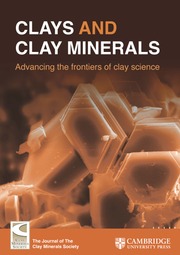Crossref Citations
This article has been cited by the following publications. This list is generated based on data provided by
Crossref.
Kanitpanyacharoen, Waruntorn
Vanorio, Tiziana
Liu, Yijin
Benmore, Chris
and
Xiao, Xianghui
2013.
Evolution of mineral fabrics and microstructures in Kimmeridge Shale upon kerogen maturation.
p.
2783.
Allan, Adam M.
Vanorio, Tiziana
and
Dahl, Jeremy E. P.
2013.
Thermal maturation-induced variation of P-wave anisotropy of organic-rich shale.
p.
2767.
Kanitpanyacharoen, Waruntorn
Parkinson, Dilworth Y.
De Carlo, Francesco
Marone, Federica
Stampanoni, Marco
Mokso, Rajmund
MacDowell, Alastair
and
Wenk, Hans-Rudolf
2013.
A comparative study of X-ray tomographic microscopy on shales at different synchrotron facilities: ALS, APS and SLS.
Journal of Synchrotron Radiation,
Vol. 20,
Issue. 1,
p.
172.
Allan, Adam M.
Vanorio, Tiziana
and
Dahl, Jeremy E. P.
2014.
Pyrolysis-induced P-wave velocity anisotropy in organic-rich shales.
GEOPHYSICS,
Vol. 79,
Issue. 2,
p.
D41.
Suuronen, Jussi-Petteri
Matusewicz, Michał
Olin, Markus
and
Serimaa, Ritva
2014.
X-ray studies on the nano- and microscale anisotropy in compacted clays: Comparison of bentonite and purified calcium montmorillonite.
Applied Clay Science,
Vol. 101,
Issue. ,
p.
401.
Wenk, Hans-Rudolf
Lutterotti, Luca
Kaercher, Pamela
Kanitpanyacharoen, Waruntorn
Miyagi, Lowell
and
Vasin, Roman
2014.
Rietveld texture analysis from synchrotron diffraction images. II. Complex multiphase materials and diamond anvil cell experiments.
Powder Diffraction,
Vol. 29,
Issue. 3,
p.
220.
Ghanizadeh, Amin
Gasparik, Matus
Amann-Hildenbrand, Alexandra
Gensterblum, Yves
and
Krooss, Bernhard M.
2014.
Experimental study of fluid transport processes in the matrix system of the European organic-rich shales: I. Scandinavian Alum Shale.
Marine and Petroleum Geology,
Vol. 51,
Issue. ,
p.
79.
Ghanizadeh, Amin
Amann-Hildenbrand, Alexandra
Gasparik, Matus
Gensterblum, Yves
Krooss, Bernhard M.
and
Littke, Ralf
2014.
Experimental study of fluid transport processes in the matrix system of the European organic-rich shales: II. Posidonia Shale (Lower Toarcian, northern Germany).
International Journal of Coal Geology,
Vol. 123,
Issue. ,
p.
20.
Tang, Xuan
Zhang, Jinchuan
Jin, Zhijun
Xiong, Jinyu
Lin, Lamei
Yu, Yixing
and
Han, Shuangbiao
2015.
Experimental investigation of thermal maturation on shale reservoir properties from hydrous pyrolysis of Chang 7 shale, Ordos Basin.
Marine and Petroleum Geology,
Vol. 64,
Issue. ,
p.
165.
Thiéry, Vincent
Bourdot, Alexandra
and
Bulteel, David
2015.
Characterization of raw and burnt oil shale from Dotternhausen: Petrographical and mineralogical evolution with temperature.
Materials Characterization,
Vol. 106,
Issue. ,
p.
442.
Kanitpanyacharoen, Waruntorn
Vasin, Roman
Wenk, Hans-Rudolf
and
Dewhurst, David. N.
2015.
Linking preferred orientations to elastic anisotropy in Muderong Shale, Australia.
GEOPHYSICS,
Vol. 80,
Issue. 1,
p.
C9.
Kalani, Mohsen
Jahren, Jens
Mondol, Nazmul Haque
and
Faleide, Jan Inge
2015.
Petrophysical implications of source rock microfracturing.
International Journal of Coal Geology,
Vol. 143,
Issue. ,
p.
43.
Kaufhold, S.
Grathoff, G.
Halisch, M.
Plötze, M.
Kus, J.
Ufer, K.
Dohrmann, R.
Ladage, S.
and
Ostertag-Henning, Ch.
2016.
Filling the Gaps – from Microscopic Pore Structures to Transport Properties in Shales.
p.
163.
Houben, M.E.
Barnhoorn, A.
Wasch, L.
Trabucho-Alexandre, J.
Peach, C.J.
and
Drury, M.R.
2016.
Microstructures of Early Jurassic (Toarcian) shales of Northern Europe.
International Journal of Coal Geology,
Vol. 165,
Issue. ,
p.
76.
Houben, M.E.
Barnhoorn, A.
Lie-A-Fat, J.
Ravestein, T.
Peach, C.J.
and
Drury, M.R.
2016.
Microstructural characteristics of the Whitby Mudstone Formation (UK).
Marine and Petroleum Geology,
Vol. 70,
Issue. ,
p.
185.
Leu, L.
Georgiadis, A.
Blunt, M. J.
Busch, A.
Bertier, P.
Schweinar, K.
Liebi, M.
Menzel, A.
and
Ott, H.
2016.
Multiscale Description of Shale Pore Systems by Scanning SAXS and WAXS Microscopy.
Energy & Fuels,
Vol. 30,
Issue. 12,
p.
10282.
Schlosser, J.
Grathoff, G.H.
Ostertag-Henning, C.
Kaufhold, S.
and
Warr, L.N.
2016.
Mineralogical changes in organic-rich Posidonia Shale during natural and experimental maturation.
International Journal of Coal Geology,
Vol. 157,
Issue. ,
p.
74.
Milliken, Kitty L.
and
Curtis, Mark E.
2016.
Imaging pores in sedimentary rocks: Foundation of porosity prediction.
Marine and Petroleum Geology,
Vol. 73,
Issue. ,
p.
590.
Ougier-Simonin, Audrey
Renard, François
Boehm, Claudine
and
Vidal-Gilbert, Sandrine
2016.
Microfracturing and microporosity in shales.
Earth-Science Reviews,
Vol. 162,
Issue. ,
p.
198.
Klaver, Jop
Desbois, Guillaume
Littke, Ralf
and
Urai, Janos L.
2016.
BIB-SEM pore characterization of mature and post mature Posidonia Shale samples from the Hils area, Germany.
International Journal of Coal Geology,
Vol. 158,
Issue. ,
p.
78.

